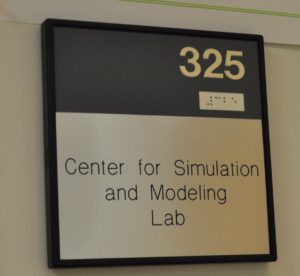 Of the 21 iterations of the definition of the word ‘scale’ in the Oxford Dictionary, one is particularly applicable to the latest 4-VA grant project “Scalable Molecular Dynamics;” that is: “the full range of different levels of people or things.” This definition illustrates both the scope of the research and the collaborators involved in the effort.
Of the 21 iterations of the definition of the word ‘scale’ in the Oxford Dictionary, one is particularly applicable to the latest 4-VA grant project “Scalable Molecular Dynamics;” that is: “the full range of different levels of people or things.” This definition illustrates both the scope of the research and the collaborators involved in the effort.
While orchestrating a variety of other projects and programs at Mason’s Center for Simulation and Modeling (CSM) located in the College of Science, lead PI Dr. Estela Blaisten-Barojas took on one more when she applied for and received the 4-VA grant. Blaisten-Barojas was interested in undertaking a serious study of predictive computational and simulation-based approaches in chemical and materials sciences combined with engineering approaches. This study is central to finding innovative solutions for environmental pollution, healthcare, sustainable energy resources, global warming, and ways of fighting terrorism, crucial to both Virginia’s and the nation’s competitiveness in science and engineering.

To launch and deliver “Scalable Molecular Dynamics” a full-throttled balancing act was necessary, Blaisten-Barojas called in her colleague Dr. Robert Handler from the Mechanical Engineering department at Volgeneau and Dr. Eric Weisel, Executive Director, Virginia Modeling, Analysis, and Simulation Center (VMASC) at Old Dominion University, a 4-VA partner school. Then, she added a number of talented students, including Gideon Gogovi, Scott Hopkins and James Andrews, to her 4-VA team. Each brought countless hours of research to the project – enhancing both the collective mission and their personal portfolios.
Blaisten-Barojas was interested in testing computational techniques for scaling up various aspects of a molecular simulation in which a large molecule is solvated or flows in a viscous solvent. Specifically, they studied the atomistic behavior of the polymer polyacrylamide, or PAM. This polymer, when immersed in gel-type solvents, is used for the separation of proteins, an important component in bio detection.
The team’s research identified several interesting and notable characteristics regarding the structure and energetics of PAM in implicit and explicit solvents – as team members studied the chain shape and the diversity of coiling and twists of the polymer in the various solvents. The researchers noted closely the changes in shape from an elongated spaghetti string to a more football-like object. Importantly, based on what they learned, they were able to make some scaling up predictions about how big structures can grow. This new understanding is valuable for efficiently controlling the performance of devices based on molecular components.Once the project got moving, the full range definition of scalability was set in motion. In fact, the simulations were so complex that they reached the maximum allowed in Argo, Mason’s centralized research computing cluster.


Already, two conference presentations have been made based on the research – a talk and a poster at the recent American Chemical Society (ACS) Mid Atlantic Research Meeting; two journal papers are in submission.
Blaisten-Barojas notes that although the research, results and dissemination have been gratifying, it was the new-found relationship with the VMASC which capped the full range of different levels of people and subjects concept. “This is a very important first step,” Blaisten-Barojas notes. “We now know who they are and they know who we are. I know that if they see possibilities in some of their initiatives, they will knock on our door first and we will do the same.”
